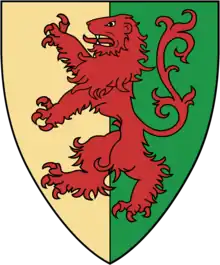Marshal (noble family)
The Marshal family was a noble family of Anglo-Norman origins. They arrived in England from Normandy following the Norman Conquest of 1066. Their name, Marshal, was a Frankish term for “a person who tended horses”. By 1066 the term was used for a position in royal and aristocratic households.
| Marshal | |
|---|---|
| Family of Earls and Marshals | |
 | |
| Country | England’s territory at the time of the Plantagenets |
| Etymology | Marshal, Frankish: “a person who tended horses” |
| Place of origin | Normandy |
| Founded | 12th century (first known member) |
| Founder | Gilbert Giffard |
| Final ruler | Ansel Marshal (as Earl of Pembroke), John Marshal (as Baron Marshal) |
| Final head | Hawise and Ellen Marshal, daughters of William Marshal, 1st Baron Marshal |
| Titles | List
|
History
The first known member of the Marshal family is Gilbert Giffard, who was a tenant of Glastonbury manor in Winterbourne Monkton in Wiltshire, and held a position as a marshal to the king of England.[1] The surname "Giffard" is a common Norman sobriquet, and it means "chubby-cheeks". While it is unlikely that Gilbert was related to Walter Giffard, he may have been related to the Giffards of Brimpsfield.[2]
When he died, his son, John FitzGilbert[3] (died 1165), inherited his position. John was a man that fought for Empress Matilda (Daughter of Henry I) in her unsuccessful struggle to gain the throne from her cousin, King Stephen.[4][5] Siding with Matilda costed him an eye, which he lost when the enemies set fire to Wherwell Abbey, where he was hiding. John later won the hereditary title of Lord Marshal.[6]
John’s first son was John Marshal (II), who inherited his position as Lord Marshal and retained it until his death in 1194. He only had one known son, also called John Marshal (III), but he was illegitimate, so the title went to his brother instead.[7] The title will be later claimed by a descendant of this illegitimate line, William Marshal, 1st Baron Marshal.
John (II)’s brother was the well-known William Marshal, 1st Earl of Pembroke. He was formally appointed Lord Marshal by Richard the Lionheart. William served five English kings in his lifetime: Henry II, Henry "the Young King", Richard I "The Lionheart", John Lackland, and Henry III, to whom he became regent in 1216. In 1199 he became the Earl of Pembroke, having married Isabel de Clare.[8]
After William died in 1219,[8] the titles of Lord Marshal and Earl of Pembroke eventually passed on to all of his sons, as none of them had any legitimate issue:
- William Marshal, 2nd Earl of Pembroke
- Richard Marshal, 3rd Earl of Pembroke
- Gilbert Marshal, 4th Earl of Pembroke
- Walter Marshal, 5th Earl of Pembroke
- Ansel Marshal, 6th Earl of Pembroke
After Ansel’s death, the title of Earl of Pembroke became extinct (but re-created in 1247), and the title of Lord Marshal was given to the husband of his sister Maud, Hugh Bigod, 3rd Earl of Norfolk. The current Duke of Norfolk still holds the title.
However, another of William’s titles, Earl Marshal of Ireland, was not inherited by his children, but by the previously mentioned John Marshal (III), his nephew. The title was held by that line of the family until the death of John Marshal, 2nd Baron Marshal, when it was given to his sister Hawise’s husband, Robert Morley, 2nd Baron Morley, in absence of any other family members.
Family members
- Gilbert Gifford
- John FitzGilbert
- John[9]
- Gilbert [9]
- John Marshal (II)
- John Marshal (III), illegitimate
- (Unknown name) Marshal
- William Marshal (III)
- John Marshal (IV)
- William Marshal, 1st Baron Marshal
- John Marshal, 2nd Baron Marshal
- Hawise Marshal (married Robert Morley)
- Ellen Marshal
- William Marshal, 1st Baron Marshal
- John Marshal (IV)
- William Marshal (III)
- (Unknown name) Marshal
- John Marshal (III), illegitimate
- William Marshal, 1st Earl of Pembroke
- William Marshal, 2nd Earl of Pembroke
- Richard Marshal, 3rd Earl of Pembroke
- Maud Marshal
- Gilbert Marshal, 4th Earl of Pembroke
- Walter Marshal, 5th Earl of Pembroke
- Isabel Marshal
- Sibyl Marshal (married William de Ferrers)
- Eva Marshal
- Ansel Marshal, 6th Earl of Pembroke
- Joan Marshal (mother of Joan de Munchensi)
- Henry Marshal
- Ansel Marshal (household knight)
- John FitzGilbert
References
- N. E. Stacy, Feb. 1999, Henry of Blois and the Lordship of Glastonbury. English Historical Review.
- Crouch, David (2002). William Marshal : knighthood, war and chivalry, 1147-1219. Internet Archive. London ; New York : Longman. ISBN 978-0-582-77222-9.
- Classical Numismatic Group (2012-05-23). CNG Auction 90 [Part II].
- "William Marshal, 1st earl of Pembroke | Facts & Biography | Britannica". www.britannica.com. Retrieved 2023-05-11.
- Chadwick, Elizabeth (2009-10-11). "LIVING THE HISTORY: Biography of John Marshal". LIVING THE HISTORY. Retrieved 2023-05-11.
- "Marshal, John (d. 1165), marshal". Oxford Dictionary of National Biography. doi:10.1093/ref:odnb/18122. Retrieved 2023-05-11.
- Nicolas, Nicholas Harris (1825). Vol. 2: A synopsis of the peerage of England : exhibiting, under alphabetical arrangement, the date of creation, descent and present state of every title of peerage which has existed in this country since the conquest. In two volumes / by Nicholas Harris Nicolas, Esq. of the Inner Temple, barrister at law; fellow of the Society of Antiquaries. State Library of Pennsylvania. Printed by J. Nichols and Son for C. and J. Rivington, St. Paul's Churchyard and Waterloo Place, and 17 others.
- Thomas Leckie Jarman (1930). William Marshal First Earl Of Pembroke And Regent Of England 1216 1219.
- Thomas Leckie Jarman (1930). William Marshal First Earl Of Pembroke And Regent Of England 1216 1219., “Soon afterwards John died (probably 1165) and two sons, Gilbert and John, the issue of his first marriage, did not survive him long”.